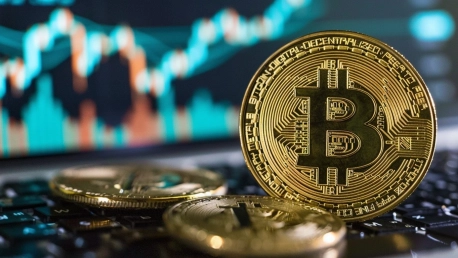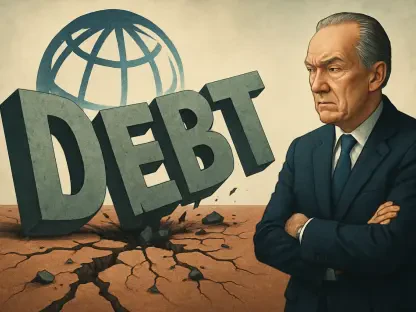The U.S. banking sector is facing a troubling landscape that may have significant repercussions for broader financial markets, including equities and cryptocurrency sectors like bitcoin. Recent findings by federal regulators have raised red flags about the health of major banks, while noted market strategists such as Gareth Soloway are voicing concerns about looming economic instability. As these factors intertwine, investors are left contemplating the future of their portfolios in an increasingly uncertain environment. The intricate web of financial activities, regulatory oversight, and market dynamics paints a picture fraught with potential volatility, urging stakeholders to adopt cautious and strategic stances.
Regulatory Scrutiny on Major Banks
Federal regulators, including the Federal Deposit Insurance Corporation (FDIC) and the Federal Reserve, have issued alarming findings about the state of major U.S. banks. Specifically, these regulators have highlighted deficiencies in the “living wills” of prominent financial institutions like Bank of America, Citigroup, Goldman Sachs, and JPMorgan Chase. These “living wills” are crucial as they outline how these banks would achieve a rapid and orderly resolution in the event of a financial crisis. The shortcomings in these plans suggest that these banks are not fully prepared to handle severe financial distress without extraordinary government intervention. This situation harkens back to the systemic issues that triggered the 2008 financial crisis, raising concerns about the effectiveness of the post-crisis regulatory framework designed to prevent another catastrophic collapse.The regulatory scrutiny extends beyond the mere existence of these plans to their practical feasibility during times of crisis. The FDIC and the Federal Reserve have emphasized that the banks’ current strategies are inadequately detailed and potentially unrealistic, thus failing to ensure a stable financial ecosystem. This lack of preparedness draws alarming parallels to pre-2008 conditions, where overleveraging and inadequate risk management led to a global economic meltdown. Although the regulatory bodies have mandated these living wills to introduce systemic safeguards, the current revelations indicate lingering vulnerabilities that could very well spiral out of control if not promptly addressed. The industry is now in a race against time to rectify these gaps, accentuating the critical role of sound risk management and robust contingency planning.
Managing Bad Debt
Market strategist Gareth Soloway has raised additional red flags by pointing out the increasing amounts of bad debt that these banks are reportedly offloading. High interest rates have particularly driven losses in mortgage-backed securities, adding substantial strain to banks’ financial health. Moreover, the commercial real estate market is in a precarious state, echoing the types of losses seen during the late-2000s financial crisis. The shedding of bad debt by these major banks can serve as a bellwether for broader financial instability. As these institutions attempt to clean their balance sheets, the knock-on effects could ripple through the economy. Investors and policymakers alike are watching closely, aware that how these issues are managed could dictate the economic landscape for years to come.The gravity of the commercial real estate dilemma cannot be understated. The sector is already grappling with rising vacancy rates and plummeting property values, exacerbated by the high-interest environment. This scenario not only strains the banks’ balance sheets but also poses a broader economic threat. If significant institutions continue to offload bad debt in bulk, the ensuing market flux might erode investor confidence and trigger tighter financial conditions, amplifying economic stress. For market participants, this presents a dual challenge: on one hand, they must assess the health and future prospects of their investments; on the other, they need to navigate an increasingly complex and volatile landscape. As the industry sorts through these financial intricacies, vigilance and keen strategic planning are paramount.
Stock Market Implications
The turmoil within the banking sector has already started to manifest in the stock market. Soloway has observed technical deterioration in the stock performance of major banks, particularly noting a trend line breakdown in JPMorgan and similar patterns for Citigroup. Such technical indicators are often precursors to more widespread market corrections. The weakened stock performance of these key financial players suggests deeper underlying issues. If these patterns continue, it could lead to a significant market correction, impacting investor confidence and potentially leading to broader economic ramifications. The stock market’s stability is intricately tied to the health of these banking giants, and any sustained trouble could lead to substantial declines across various sectors.The stock market’s interconnectivity with these banking institutions highlights the system-wide risks involved. As major banks face mounting challenges, their stock valuations undergo volatile fluctuations, dampening overall market sentiment. Institutional investors and retail traders alike are left to decipher the potential long-term impacts of these trends, which could usher in a broader market downturn. The cascading effect of deteriorating stock performance in the financial sector risks pulling down seemingly unrelated sectors, fostering an environment of pervasive uncertainty. Therefore, as analysts and strategists project future market conditions, a keen eye on banking stocks serves as an essential barometer for potential economic turbulence. The implications of a faltering banking sector are far-reaching, underscoring the need for robust risk assessment and judicious investment decisions.
Bitcoin and Cryptocurrency Market Sensitivity
Bitcoin, often seen as a separate entity from traditional financial markets, is not immune to these emerging banking woes. According to Soloway, bitcoin’s recent trajectory has been closely linked to the performance of the stock market. As long as equities continue to reach new highs, bitcoin is likely to avoid significant pullbacks. However, this comes with a substantial caveat—should the Federal Reserve adopt stricter market regulations or should the stock market experience a downturn, bitcoin could face notable retreats. For instance, Soloway suggests that in the event of a market correction, bitcoin’s value might fall to the $50,000 range. This potential devaluation underscores the interconnectedness of modern financial markets. As traditional financial institutions face mounting concerns, even relatively new and speculative assets like bitcoin cannot escape unscathed.In essence, the speculative nature of bitcoin makes it highly susceptible to broader market dynamics. With growing apprehensions surrounding major financial institutions, the ripple effects could alter investor sentiment toward digital assets. The prospect of regulatory tightening adds another layer of complexity, as stricter guidelines could restrain market liquidity and increase volatility. However, bitcoin’s inherent nature as a decentralized asset coupled with its adoption as a hedge against traditional market downturns may offer it some resilience. The cyclic patterns observed in the cryptocurrency market indicate that dips might be followed by rebounds, but the magnitude and duration of these cycles remain unpredictable. As crypto investors navigate this landscape, acute awareness of regulatory actions and macroeconomic conditions becomes imperative for making informed decisions.
Broader Economic Implications
The weaknesses identified within major banks and the resulting market behaviors point to broader economic implications. Commercial real estate troubles could lead to decreased investor confidence and stunted economic growth. If banks continue to offload bad debt without resolving underlying issues, the economic strain could worsen, leading to decreased lending and tighter financial conditions, which could stifle economic activity. Additionally, increased regulatory scrutiny, while essential for long-term stability, could have short-term disruptive effects. Tighter regulations may limit banks’ operational flexibility, potentially slowing down their recovery processes and creating a more challenging environment for businesses seeking loans and investments. These factors combined could contribute to a slowed economic recovery or even push the economy into a recession.The delicate balance between regulatory oversight and economic vitality poses a significant challenge for policymakers. Ensuring long-term financial stability while mitigating immediate economic disruptions creates a tightrope walk scenario. Given the stakes, strategic interventions will be crucial in navigating potential pitfalls. For businesses and consumers, the prevailing financial conditions could translate into higher borrowing costs and limited access to credit, affecting everything from large-scale investments to everyday expenditures. Consequently, the broader economic landscape might experience slowed momentum, with growth rates tapering off and unemployment rates potentially inching upwards. These cascading effects underscore the importance of timely and pragmatic policy responses aimed at stabilizing the financial sector while nurturing economic recovery.
Strategic Investments and Vigilance
The U.S. banking sector is currently navigating a challenging terrain that could have wide-ranging effects on various financial markets, including equities and cryptocurrencies like bitcoin. Federal regulators have recently uncovered alarming issues concerning the health of major banks, further adding to the sector’s woes. Market experts, including Gareth Soloway, have expressed worries about a possible impending economic downturn, making the situation even more precarious. As these obstacles converge, investors are left to ponder the future of their assets in a constantly shifting and uncertain economic landscape.Compounding these concerns are the intricate layers of financial operations, regulatory governance, and market dynamics that collectively paint a complicated and volatile picture. This scenario is prompting many stakeholders to consider more cautious and strategic approaches to safeguard their investments. The potential for market turbulence appears high, urging all parties involved to stay vigilant and adapt to evolving conditions. Thus, it is critical for investors to stay informed and proactive in managing their portfolios amid these looming uncertainties.









